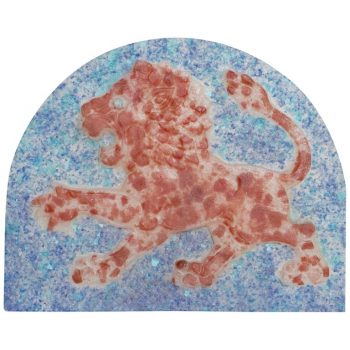Description
Jean-Léon Gérôme (1824 – 1904) FRENCH BELLUAIRE OR PLAUDITE CIVES.
This sculpture shows the scene of a Roman coliseum where a gladiator just finished his battle with a large lion. The large man dressed in a loin cloth and an arm armor with a spear is pumped up and expects the stunned crowds to cheer for him; hence the title “Plaudite Cives” which translates to Civilian applause. The lion is postmortem magnanimous with blood coming out of his mouth showing great detail throughout.
Bronze sits on a thick octagonal marble plinth with ornate brass beading. Apparently this bronze was retailed in Paris at a Tiffany Co. retail boutique after the turn of the last century. signed JL. GEROME, titled “PLAUDITE CIVES”, with the Siot Decauville foundry seal and numbered 7071; also stamped TIFFANY CO PARIS, with an original Patricia green marble plinth with brass beaded band. bronze and marble
Dimensions: 15 x 21.6 x 10.7 inches
Condition: Very good to excellent. Bronze is loose from marble plinth. Very heavy!
AVANTIQUES is dedicated to providing an exclusive curated collection of Fine Arts, Paintings, Bronzes, Asian treasures, Art Glass and Antiques. Our inventory represents time-tested investment quality items with everlasting decorative beauty. We look forward to your business and appreciate any reasonable offers. All of our curated items are vetted and guaranteed authentic and as described. Avantiques only deals in original antiques and never reproductions. We stand behind our treasures with a full money back return policy if the items are not as described.
Jean-Léon Gérôme (11 May 1824 – 10 January 1904) was a French painter and sculptor in the style now known as academicism. His paintings were so widely reproduced that he was “arguably the world’s most famous living artist by 1880.”[1] The range of his oeuvre included historical painting, Greek mythology, Orientalism, portraits, and other subjects, bringing the academic painting tradition to an artistic climax. He is considered one of the most important painters from this academic period. He was also a teacher with a long list of students. Jean-Léon Gérôme was born at Vesoul, Haute-Saône. He went to Paris in 1840 where he studied under Paul Delaroche, whom he accompanied to Italy in 1843. He visited Florence, Rome, the Vatican and Pompeii. On his return to Paris in 1844, like many students of Delaroche, he joined the atelier of Charles Gleyre and studied there for a brief time. He then attended the École des Beaux-Arts. In 1846 he tried to enter the prestigious Prix de Rome, but failed in the final stage because his figure drawing was inadequate. His painting The Cock Fight (1846) is an academic exercise depicting a nude young man and a very thinly draped young woman with two fighting cocks, with the Bay of Naples in the background. He sent this painting to the Paris Salon of 1847, where it gained him a third-class medal. This work was seen as the epitome of the Neo-Grec movement that had formed out of Gleyre’s studio (including Henri-Pierre Picou and Jean-Louis Hamon), and was championed by the influential French critic Théophile Gautier, whose review made Gérôme famous and effectively launched his career. Gérôme abandoned his dream of winning the Prix de Rome and took advantage of his sudden success. His paintings The Virgin, the Infant Jesus and Saint John and Anacreon, Bacchus and Eros took a second-class medal at the Paris Salon in 1848. In 1849, he produced the paintings Michelangelo (also called In his Studio) and A Portrait of a Lady. In 1851, he decorated a vase later offered by Emperor Napoleon III of France to Prince Albert, now part of the Royal Collection at St. James’s Palace, London. He exhibited Greek Interior, Souvenir d’Italie, Bacchus and Love, Drunk in 1851; Paestum in 1852; and An Idyll in 1853
Please also consider Avantique’s eclectic bronze collection including Barye, Barrias, Mene, Moigniez, Paillet, Paillard, Fratin, Picault, Tiffany Studios, and Cain among others. We strive to collect the highest quality sculptures in exceptional condition.





